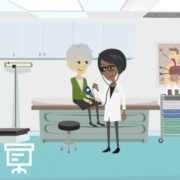What Are the Goals of ET, PV, and MF Treatment? from Patient Empowerment Network on Vimeo.
What goals are myeloproliferative neoplasm (MPN) care team members trying to achieve with ET, PV, and MF treatment? Dr. Naveen Pemmaraju reviews three factors that drive treatment decisions for quality, personalized MPN care.
Dr. Naveen Pemmaraju is Director of the Blastic Plasmacytoid Dendritic Cell Neoplasm (BPDCN) Program in the Department of Leukemia at The University of Texas MD Anderson Cancer Center. Learn more about Dr. Pemmaraju, here.
Related Programs
Transcript
Katherine Banwell:
Let’s talk about treatment goals first for ET, PV, and MF. What are the goals of treatment from a clinical perspective?
Dr. Pemmaraju:
Well, I think the goals are divided up into three factors. So, I think for the MPN patient, goal number one has to be what the patient themselves want to achieve.
Oftentimes, that’s different than what’s on the numbers with the labs and what the physician wants. So, I think a lot of our patients correctly are suffering from – or mentioning to us that they’re suffering from quality of life issues. So, fatigue is the most common manifestation of all the MPNs, followed by bone pain, night sweats, inability to concentrate, etcetera, etcetera.
So, I think quality of life is the goal of most people, and I think that’s an admirable goal. And some of the medicines can help that. Some can actually hurt that in the short term. So, let’s put that as bucket number one. What does the patient want to achieve? Usually, it’s the alleviation of fatigue, itching, bone pain, etcetera.
Number two, I think, is the sort of on-paper game, if you will, right? So, what do the labs show, what does the bone marrow biopsy show, what does the spleen show? I think all of that is good, too, in that bucket. And clearly, if someone has transfusion dependent anemia, two times a week needing blood transfusions, and whatever treatment you can do can alleviate that down to once a week, once a month never – okay, that’s a win for the patient.
And then I think, finally, our goals. You’re right. You asked me specifically what are my goals for our patients? Well, I want to see that your overall survival has improved if I can. So, your length of life, your quality of life has improved. Minimization of side effects from whatever therapy we’re doing. If we’re going on a clinical trial or combining therapies in a novel way, that you’re not experiencing some brand new or idiosyncratic toxicity or side effect.
And then, finally, I think the key is to monitor for, let’s say, other things. Are you developing a second cancer? A second blood cancer. Are you having another problem that’s outside of your MPN, such as iron deficiency anemia or thyroid disease? Something that’s extremely common, has nothing to do with the MPN, but is also happening. And then do you have a healthcare team?
I failed to mention in your earlier question the primary care doctor., right? Let’s mention that person as well. If our patients have the general practitioner who they had already been seeing before the MPN diagnosis, or at least established one after, then some of these important aspects, like cancer screening, cholesterol checks, some of these other important things can be done in parallel to the MPN therapy and then, of course, combined at different points.
So, these are kind of my benchmarks for goals of therapy. They will vary from patient to patient and, of course, from case to case. The patient with advanced intermediate to high-risk myelofibrosis going to transplant, well, that’s markedly different from the patient who’s young with ET with no blood clots and relatively controlled blood counts.
Katherine Banwell:
So, you just mentioned a couple of factors that you take into consideration, but there are others as well, I think. What about the patient’s age and overall health, for instance?
Dr. Pemmaraju:
Could not be more important. You’re right. I think age – and let’s use that as a surrogate for what we call ECOG performance data.
So, the overall kind of fitness of a patient, may be the most important factor. And then followed by these other conditions, so-called co-morbidities. I’d like to talk about that for a second because that’s a lot of the program here. Depending on a patient’s age, performance status, fitness, and other organs that are involved, that actually leads to a couple of important points.
One, it may limit or reduce the number of treatment options that a person has based on their ability to even tolerate it in the first place. Both oral chemos that are available, some of these clinical trials that need to use an IV drug.
Number two, it may predict how your overall survival is going to be. So, perhaps your MPN, as we used in the other example, you have an earlier stage MPN that really doesn’t require treatment. It requires active observation.
But then on the other hand, you have advanced heart disease or kidney disease. That may actually do you more harm in the end.
And then, finally, right, is this concept that you have the co-morbidities and then you have the MPN and then they kind of change and morph over time where one is the dominant issue, the other isn’t. And so, you do need that decision care team as you were mentioning earlier. So, let’s definitely say that out loud that that matters. And I think it also reminds us that nothing is in a vacuum. The MPN doesn’t exist in an isolated space, right? So, your MPN co-exists with your heart disease, your kidney disease, your lung disease, your past, your present habits, anything.
Dr. Pemmaraju:
I think sometimes, as physicians, we may not ask, and as patients, we forget to mention, oh, X, Y, Z in my history, or “Oh, I’m taking this herbal supplement.” Sometimes these things are important to mention.
So, when in doubt, bring up everything to your care team so that you can make decisions together.
Katherine Banwell:
It might help to make notes before you go in to talk to your doctor.
Dr. Pemmaraju:
Absolutely. That doesn’t hurt, and it could help you at least organize your own thoughts even if you don’t use them in the visit.


















